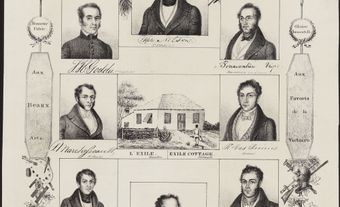The Klondike Gold Rush was touched off by the 16 August 1896 discovery of placer gold (the claim was staked on August 17) on Rabbit (later Bonanza) Creek, a tributary of the Klondike River, by George Washington Carmack and his Indian brothers-in-law, "Skookum Jim" and "Tagish Charley." This accidental find was the result of a tip by a Canadian prospector, Robert Henderson, now credited as co-discoverer. The gold rush that followed was confined that first year to the Yukon interior. Miners already on the scene staked every creek (or "pup") in the Klondike and Indian river watersheds, including the fabulously rich Eldorado.
The world did not learn of the strike until some of these newly rich pioneers reached the West Coast by steamship in mid-July 1897. The Seattle Post-Intelligencer's description of "a ton of gold" actually touched off the stampede. The effect on the depressed economy was instantaneous as hoarded funds were freed to finance some 100,000 amateur goldseekers who started north that fall and winter. The rich went all the way by water; the poor struggled over the White Pass and Chilkoot Pass, then down the Yukon River in handmade craft; the foolhardy took the "all-Canadian" routes through BC or out of Edmonton and found themselves spending 2 years on the trail.
Soon much of Alaska and the Canadian Northwest was speckled with men and pack animals. Every Canadian community from Winnipeg to Victoria was permanently affected by the boom. The Canadian North was seen as something more than frozen wasteland: Klondike fever was the catalyst for a chain of later mineral discoveries. Sixty steamboats plied the Yukon. The new town of Dawson at the Klondike's mouth, with a floating population of some 30 000, became the largest community north of Seattle and west of Winnipeg, boasting telephones, electricity and motion picture theatres. Prostitution was tolerated; saloons, dancehalls and gaming parlours ran wide open except on Sundays.
The North-West Mounted Police kept Dawson a law-abiding town while the Yukon Field Force, a military unit, maintained Canadian sovereignty in the face of a predominantly American population. The Spanish-American War and the news of a strike at Nome, Alaska, ended the stampede in the summer of 1898. By then, it is estimated, the goldseekers had spent some $50 million reaching the Klondike, a sum about equal to the amount taken from the diggings in the 5 years following Carmack's discovery.
See also Gold Rushes.

 Share on Facebook
Share on Facebook Share on X
Share on X Share by Email
Share by Email Share on Google Classroom
Share on Google Classroom


